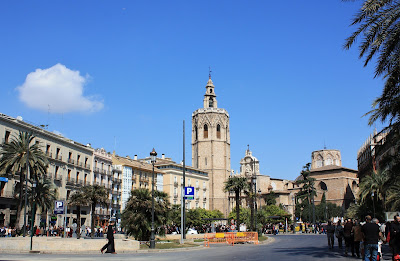Valencia is famous for its unique and somewhat crazy annual fiery fiesta - ‘Las Fallas’ - which is celebrated over 5 days throughout the 3rd week of March leading up to the feast day of St. Joseph. It involves months of effort in creating gigantic paper mâché effigies which will be paraded in the streets packed with revellers from all over the world, many of whom are there specifically for this event. The fiesta will culminate on the last day, when one can witness the dramatic grotesque figures being set ablaze in a massive & spectacular bonfire. If you have a thing for pyrotechnics or simply love the smell of gunpowder…you know where to go!
Las Fallas aside, there is much more to this intriguing Mediterranean city, which is the 3rd largest in Spain. It is here where the popular Spanish dish ‘paella’ is said to have originated from, and the locals here have their own unique language called 'Valencian' (a variant of Catalan).

Above: The Tower of Serranos, the gateway into the historic center of Valencia.
The old historical part of the city boasts of several impressive towers & ancient gothic buildings, one of which is the La Lonja de la Seda (The Silk Exchange) - a UNESCO World Heritage Site. Given the same kind of reverence normally shown to the church yet not built for religious purposes, this stately building represented the power & importance of mercantile trading during the 15th Century.

Above: The lofty interior of the main hall in the La Lonja consists of 24 tall spiral columns. The external façade however, is adorned with many mysterious and even obscene gargoyles, each appearing to bear a symbolic message.
Not far from the La Lonja, you can find the Central Market. Built in the 20th Century in the area where most of their bustling commercial activities used to and continue to take place, it provided the people of Valencia a better and more attractive environment to do their trade.


Above: The Central Market and the outdoor vendors selling their wares on the streets outside.

Above: One other monumental icon of the city is the 60m tall Micalet Bell Tower.


Above: Right next to the Micalet is the Cathedral of Valencia, with a pretty baroque façade but set in a rather tight space hence the concaved design.


Above: At the back end of the Cathedral is the Plaza de la Virgen, a place where it’s almost always crowded.
At Plaza de la Reina, yet another bell tower (smaller but still beautiful) can be spotted.

Above: The baroque bell tower of the Santa Catalina Church.

Above: The gothic exterior of Santa Catalina Church.


Above: The 19th Century neo-classical circular brick structure of the Plaza de Toros Bull Ring consists of 4 levels of arcaded galleries. The ground floor is used as stall spaces for vendors selling all sorts of knick knacks.
My personal favourite building in the historic center is none other than the Palacio del Marqués de Dos Aguas. Originally a palace built in baroque style, this building has since been refurbished and what’s extraordinary are the frescoes on the building and the magnificent alabaster façade added at the entrance.
My personal favourite building in the historic center is none other than the Palacio del Marqués de Dos Aguas. Originally a palace built in baroque style, this building has since been refurbished and what’s extraordinary are the frescoes on the building and the magnificent alabaster façade added at the entrance.

Above: The Palacio del Marqués de Dos Agua. Today, the building is used as the Museo Nacional de Cerámica and it houses exhibits of fine porcelain and ceramics.
Stay tuned for Part II on Valencia!
Stay tuned for Part II on Valencia!






I'v lived just 10 minutes up the road from Denia for over 6 years and have never seen some of the things that you have taken photos of ! - I really should get out more !
ReplyDelete